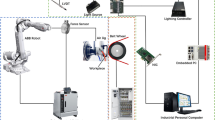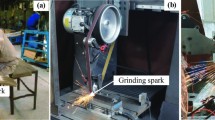Abstract
Accurately predicting the material removal rate (MRR) in belt grinding is challenging because of the randomly distributed multiple cutting edges, flexible contact, and continuous wear of the abrasive grains, undermining the ability to achieve the expected machining requirements for belt grinding using the planned parameters. With the development of sensing technology, big data, and intelligent algorithms, online identification methods for material removal through sensing signals have gained traction. A vision-based material removal monitoring method in the belt grinding process was investigated by adopting the gene expression programming (GEP) algorithm. First, the relationship between the grinding parameters and MRR was investigated through a series of experiments. Second, methods of image shooting distance calibration and automatic image segmentation were established. Furthermore, the definition and quantification method of 11 features related to the color, texture, and energy of spark images are described, based on which the features are extracted. Then, the optimal feature subset was determined by analyzing the fluctuation degree and correlation with MRR by computing the coefficient of variation of the features and Pearson’s coefficient of features and MRR, respectively. Finally, a continuous function model including the selected features was obtained using the GEP method. The predicted results and testing time were compared with those of other methods such as LightGBM, convolutional neural network (CNN), support vector regression (SVR), and BP neural network. The results show that the MRR prediction model based on the GEP algorithm can obtain explicit function expressions and is highly effective in predicting accuracy and test time, which is of utmost significance for accurate and efficient acquisition of MRR data online.















Similar content being viewed by others
Availability of data and materials
The datasets used or analyzed during the current study are available from the corresponding author on reasonable request.
References
Wang TT, Zou L, Wan QH, Zhang XH, Li YJ, Huang Y (2021) A high-precision prediction model of surface roughness in abrasive belt flexible grinding of aero-engine blade. J Manuf Process 66:364–375
Pandiyan V, Tjahjowidodo T, Samy M (2016) In-process surface roughness estimation model for compliant abrasive belt machining process. Procedia Cirp 46:254–257
Li LF, Feng HJ, Chen HB, Chen XQ (2021) A novel material removal rate model based on single grain force for robotic belt grinding. J Manuf Process 68:1–12
Zhe H, Li JY, Liu YM, Wang WY (2021) Investigation of conditions leading to critical transitions between abrasive belt wear modes for rail grinding. Wear 484–485(1–2):204048
Wang G, Wang Y, Xu Z (2009) Modeling and analysis of the material removal depth for stone polishing. J Mater Process Technol 209(5):2453–2463
Zhe H, Li JY, Liu YM, Wang WX (2021) Investigation of conditions leading to critical transitions between abrasive belt wear modes for rail grinding. Wear 484–485(1–2):204048
Yang ZY, Chu Y, Xu XH, Huang HJ, Zhu DH, Yan SJ, Ding H (2021) Prediction and analysis of material removal characteristics for robotic belt grinding based on single spherical abrasive grain model. Int J Mech Sci 190:106005
Ren X, Cabaravdic M, Zhang X, Kuhlenk TB (2007) A local process model for simulation of robotic belt grinding. Int J Mach Tools Manuf 47(6):962–970
Hammann G (1998) Modellierung des Abtragsverhaltens elastischer robot-ergefuehrter Schleifwerkzeuge, PhD Thesis, University Stuggart
Zhang XQ, Chen HB, Xu JJ, Song XF, Wang JW, Chen XQ (2018) A novel sound-based belt condition monitoring method for robotic grinding using optimally pruned extreme learning machine. J Mater Process Technol 260:9–19
Ren LJ, Zhang GP, Zhang L, Zhang Z, Huang YM (2018) Modelling and investigation of material removal profile for computer controlled ultra-precision polishing. Precis Eng 55:144–153
Rabinowicz E, Tanner RI (1966) Friction and wear of materials. J Appl Mech 33(2):479
Cabaravdic, Kuhlenköetter B (2005) Belt grinding processes optimization. Mo Metal loberfläche 4:44–47
Pandiyan V, Caesarendra W, Tjahjowidodo T, Praveen G (2017) Predictive modelling and analysis of process parameters on material removal characteristics in abrasive belt grinding process. Appl Sci 4:363
Pandiyan V, Shevchik S, Wasmer K, Castagne S, Tjahjowidodo T (2020) Modelling and monitoring of abrasive finishing processes using artificial intelligence techniques: a review. J Manuf Process 57:114–135
Gao K, Chen H, Zhang X, Ren X, Chen J, Chen X (2019) A novel material removal prediction method based on acoustic sensing and ensemble XGBoost learning algorithm for robotic belt grinding of Inconel 718. Int J Adv Manuf Technol 105:217–232
Ren LJ, Zhang GP, Wang Y, Zhang Q, Wang F, Huang YM (2019) A new in-process material removal rate monitoring approach in abrasive belt grinding. Int J Adv Manuf Technol 104(5–8):2715–2726
Wang NN, Zhang GP, Ren LJ, Pang WJ (2021) Vision and sound fusion-based material removal rate monitoring for abrasive belt grinding using improved LightGBM algorithm. J Manuf Process 66:281–292
Rajmohan B, Radhakrishnan V (1994) On the possibility of process monitoring in grinding by spark intensity measurements. J Manuf Sci Eng 116(1):124–129
Rajmohan B, Radhakrishnan V (1992) A study on the thermal aspects of chips in grinding. Int J Mach Tools Manuf 32(4):563–569
Ferreira C (2001) Gene Expression Programming: a new adaptive algorithm for solving problems. Complex Syst 13(2):87–129
Wang NN, Zhang GP, Pang WJ, Ren LJ, Wang YP (2021) Novel monitoring method for material removal rate considering quantitative wear of abrasive belts based on LightGBM learning algorithm. Int J Adv Manuf Technol 114(11–12):1–13
Funding
This work was supported by the Shaanxi Province key projects (grant number 2017ZDXM-GY-133).
Author information
Authors and Affiliations
Contributions
Lijuan Ren performed the analysis and summary of the experimental data and was a major contributor in writing the manuscript. Nina Wang, Zhijian Yang, Yongchang Li, and Wanjing Pang participate in carrying out grinding experiments. Guangpeng Zhang is responsible for the project management. All the authors read and approved the final manuscript.
Corresponding author
Ethics declarations
Ethics approval
All data in this paper comes from machining grinding experiments and does not involve ethical issues.
Consent to participate
Not applicable.
Consent for publication
Not applicable.
Conflicts of interest
The authors declare no competing interests.
Additional information
Publisher's note
Springer Nature remains neutral with regard to jurisdictional claims in published maps and institutional affiliations.
Rights and permissions
About this article
Cite this article
Ren, L., Wang, N., Pang, W. et al. Modeling and monitoring the material removal rate of abrasive belt grinding based on vision measurement and the gene expression programming (GEP) algorithm. Int J Adv Manuf Technol 120, 385–401 (2022). https://doi.org/10.1007/s00170-022-08822-z
Received:
Accepted:
Published:
Issue Date:
DOI: https://doi.org/10.1007/s00170-022-08822-z




